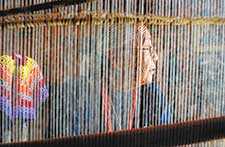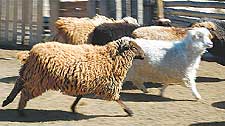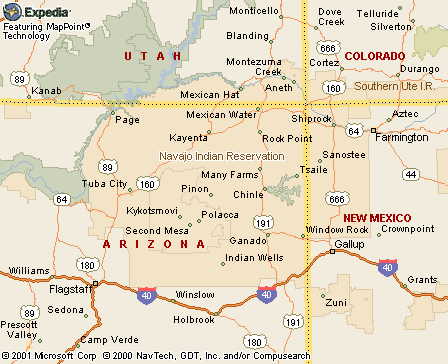|
|
Canku Ota |
|
|
(Many Paths) |
||
|
An Online Newsletter Celebrating Native America |
||
|
January 10, 2004 - Issue 104 |
||
|
|
||
|
Reweaving a historic bond |
||
|
by Judy Nichols - The Arizona
Republic
|
||
|
credits: photo
1:When she was younger, Navajo weaver Sarah Natani worked at her
loom for eight hours a day. Now she weaves two to three hours a
day at her hogan near Shiprock, N.M.; photo 2: Churro sheep (both
photos by Mark Henle/The Arizona Republic
|
|
The scruffy-looking animals, with their short horns and long brown and black wool, are Navajo-Churro, a living symbol of the resilience of the Navajo people. The sheep were nearly wiped out during the tribe's forced relocation in the 1860s and again in the stock reductions of the 1930s. But they are making a comeback. Their prized wool, in natural colors of tan, black, brown, gray and apricot, is once again seen in the traditional work of weavers like 66-year-old Sarah Natani, who owns this herd. 'The
old ones' Francisco Vasquez de Coronado first brought the sheep to the New World in 1540, from southern Spain. In 1598, the Spanish explorer Juan de Onate brought 5,000 more.
The sheep were bred and raised by Spanish ranchers along the upper Rio Grande Valley in the 17th century, and Native Americans began to acquire animals through raids and trading. The herds caused a lifestyle change for the Navajo, from nomadic hunters to a stable agricultural existence. And they would give birth to a history of world-renowned weaving. Her
first rug "My mom was a weaver," she said. "We didn't have enough money. Weaving was the main thing we did. "She would let me finish the black part, the edge. That was the only thing she trusted me with." One day when Sarah came home from school, she found a loom her father had made for her out of strips of Levi Strauss denim. "It was outside by the sheep corral. It was so cold. My dad put up a piece of old canvas on one side and the sun would hit where I sat." When she was 9, she sold her first rug at the Sanostee Trading Post. They paid her $15 and she used $3 to buy a weaving comb that she carefully marked with her initials and still has more than 50 years later. Today, one of her 4-by-5-foot rugs sells for about $6,000. Fleece,
meat, milk They were highly resistant to diseases and had lean, tasty meat and abundant milk. They often gave birth to twins or triplets, quickly expanding the herd, and were fierce, protective mothers. Their wool, highly prized for weaving, was long, fine and low in lanolin, or oil, so it needed little washing with scarce water. They often had four horns, a sacred sign, the Navajo say. At
her fingertips "In the summers, I would come home and weave," she said. "But at 15, I just lost interest." The family kept the sheep, and her father transferred the grazing permit into her name. In 1961, she married her husband, Leo Natani, a carpenter. Four years and four children later he had an accident and couldn't work. "I went to welfare to ask for help," she said. "They told me to sell the permit before they could help me. "My mother said, 'You have 10 fingers and at the tip of each finger is value. You need to work and get things for your family. You have the sheep here. You have the wool here.' " So Sarah started weaving again. "My husband was teasing me about the fat yarn I used. His mom and sisters used thin wool. He said, 'You weave with wool large enough to rope a wild horse.' I said, 'You complain about my weaving? One day I'm going to weave better than your mom.' " "And I do," she said, chuckling. A
brown rainbow The rarest sheep are called "blue." They are born black but in the first year develop a silver-charcoal inner coat covered by a brownish-black outer coat. Sometimes the sheep are multicolored, like the "badger face," which has a black belly and legs, with an upper body of white, gray or tan, and black bars above the eye and on the cheek, nose, chin and scrotum. The wool can be shorn twice a year, rather than annually, like other sheep. And it can be sold for $1.60 to $5 a pound, compared with 10 or 15 cents a pound for other wools. Demand for Churro wool is now so great that Tierra Wools in New Mexico sells only Churro yarn and weavings, said Sophia Chavez, a director. The strong, lustrous weavings from the Churro wool are durable. Fragments of wool from a related breed have survived for centuries in the Middle East. A
twist in it She sits on a wooden kitchen chair with the legs cut off to keep her close to the ground and leans a spindle against her leg. "You have to put a twist in it before you pull it out," she explains. "I tell people, 'If you learn on a spinning wheel, you'll never learn lap spinning." She deftly twists and wraps the first few fibers, then starts rolling the spindle back and forth between her palm and the outside of her thigh. "The more you pull it out, the thinner it gets." Within minutes, she has a large chunk of yarn on the spindle, nearly 30 feet when unwound across the room. The
Long Walk To force them out, Carson began burning their villages and crops, destroying livestock and killing people. With the food supply destroyed, Carson convinced them that going to the reservation was the only way to survive. Before leaving, some released their Churro into the rugged fingers of the canyon. In 1864, Carson began to march more than 8,000 people to Bosque Redondo Reservation, 300 miles away. Hundreds died of cold and starvation on what the tribe now calls the "Long Walk." More died after they arrived at the barren camp. Four years later, they were allowed to return home. Spider
Woman The story of Spider Woman is part of the creation story, said Freddie Johnson, cultural specialist at the Phoenix Indian Center. Spider Man told her how to make a loom, with crosspoles of sky and earth cords, warp sticks of sunrays, healds of rock crystal and sheet lightning. The batten was a sun halo, and white shell made the comb. The spindles were made of lightning. Spider Man told them: "From now on, when a baby girl is born to your tribe you shall go and find a spider web which is woven at the mouth of some hole; you must take it and rub it on the baby's hand and arm. Thus, when she grows up she will weave, and her fingers and arms will not tire from the weaving." Stock
reductions More than 250,000 Navajo sheep and goats, and tens of thousands of Navajo horses were killed by federal agents. Elders still cry when they remember. The
loom "Before, my loom fell apart all the time," she said. When her children were in school, Sarah would weave for eight hours a day. "I used to do that all the time. When you get older, you lose that." Now she weaves two to three hours a day. Sitting on her short chair, she looks at the pattern being revealed in her work. "With a rug, you spend the first half making up the design as you go," she says. "When you get to halfway, you repeat it." Only backward. Despite the intricate design, there is no measuring, no counting. It is all done by eye. There are no scissors, no bits of yarn to be trimmed. All are worked seamlessly into the piece. Navajo weavers, afraid of trapping all their creativity in one rug, traditionally leave an escape route of contrasting thread out through the border of the rug. The "Weaver's Pathway" or "Spirit Line," sometimes seen as a mistake by those who don't know the stories, leaves a way for the weaver's spirit to escape and create new works of art. Sarah takes a ball of the yarn she spun and breaks off a piece about a yard long. She begins to work it into the piece. "You want to make sure there are no big blocks of color," she says, dropping one color over the next, and picking it up. She works the yarn through and pats it down with the comb. "If there are spaces, you put designs in there." New
breeds The new breeds required more food and water. And the wool was not suited to weaving, being too greasy and having tight curls and knots. The short fibers broke easily when handspun and didn't take dyes well. Weavers began buying commercial yarns, breaking the circle between land, sheep, wool and weaving. The
best sheep "I didn't know there was weaving all over the world," Sarah said. They asked Sarah to speak. "I introduced myself. I said, 'I'm a spinner, a weaver. I have sheep.' They were all saying their sheep was the best. They started asking, 'What kind of sheep do you have?' I didn't know what kind. I said, 'They're mixed breed. I use their wool for weaving, their pelts for bedding, their meat for food.' I said, 'You all have tongue-twisting names for your sheep. Mine are the best.' "I came home that night and I asked Leo, 'What kind of sheep are we raising?' I told Leo I was so embarrassed because I didn't know." The
rebirth At the time, experts guessed the number of Churro left in North America was 200 to 400 animals. McNeal and his wife began the Navajo Sheep Project to save the breed by establishing a breeding flock. He started with six ewes and two rams, and searched the canyons for descendants of the sheep released in 1863. "He had a two-goal thrust," said Mark Peterson, now president of the project. "Saving the breed, and bringing the animals back to the traditional Navajo weavers of the Southwest." The project has provided breeding stock for several herds now on the reservation. Last year it distributed 300 ewes, rams and lambs. In 1991, Sheep is Life was established. It is a non-profit organization that provides technical assistance and seeks to restore status to sheepherding. Among its projects is a sheepshearing school with a team of Spanish shearers that travel from place to place teaching Navajo herders, plus workshops on processing wool, felting and spinning. It is also planning a summer sheep camp for young people. The American Livestock Breed Conservancy still lists the Navajo-Churro as rare, with estimates of only about 1,500 animals worldwide. A
rare encounter "When they stopped, an old man came up and was looking at the sheep. "He was crying, and he said, 'I didn't know there were any of them left.' It has that kind of meaning for them." |
|
|
www.expedia.com |
|
|
||
|
|
||
| Canku Ota is a free Newsletter celebrating Native America, its traditions and accomplishments . We do not provide subscriber or visitor names to anyone. Some articles presented in Canku Ota may contain copyright material. We have received appropriate permissions for republishing any articles. Material appearing here is distributed without profit or monetary gain to those who have expressed an interest. This is in accordance with Title 17 U.S.C. Section 107. | ||
|
Canku Ota is a copyright © 2000, 2001, 2002, 2003, 2004 of Vicki Lockard and Paul Barry. |
||
 |
 |
|
|
The "Canku Ota - A Newsletter Celebrating Native America" web site and its design is the |
||
|
Copyright © 1999, 2000, 2001, 2002, 2003, 2004 of Paul C. Barry. |
||
|
All Rights Reserved. |
||
 Beneath
towering Table Mesa in the vast northeastern corner of the Navajo
Reservation is a tiny ramshackle pen filled with about 35 sheep.
Beneath
towering Table Mesa in the vast northeastern corner of the Navajo
Reservation is a tiny ramshackle pen filled with about 35 sheep. They
were descendents of the Churra in Spanish, later corrupted to Churro,
an ancient Iberian breed, and were used by Spanish Conquistadors
to help feed and clothe their soldiers.
They
were descendents of the Churra in Spanish, later corrupted to Churro,
an ancient Iberian breed, and were used by Spanish Conquistadors
to help feed and clothe their soldiers. 